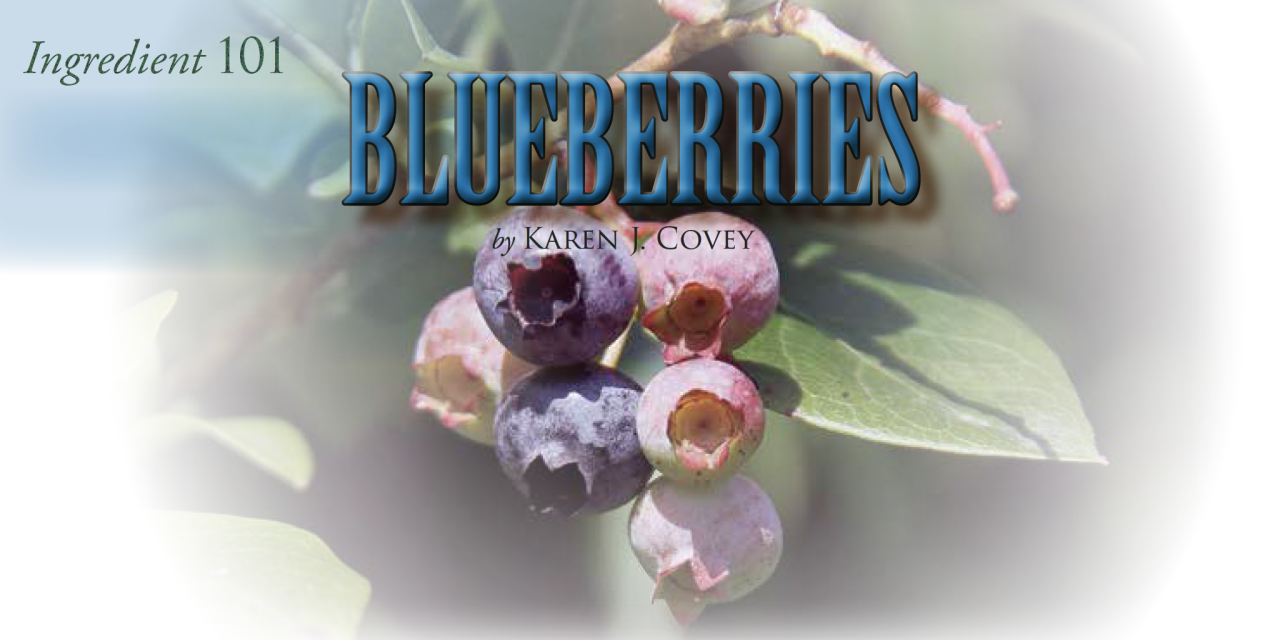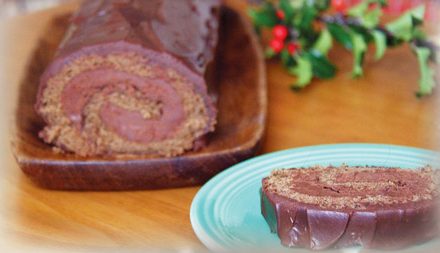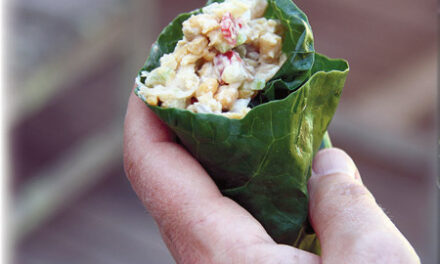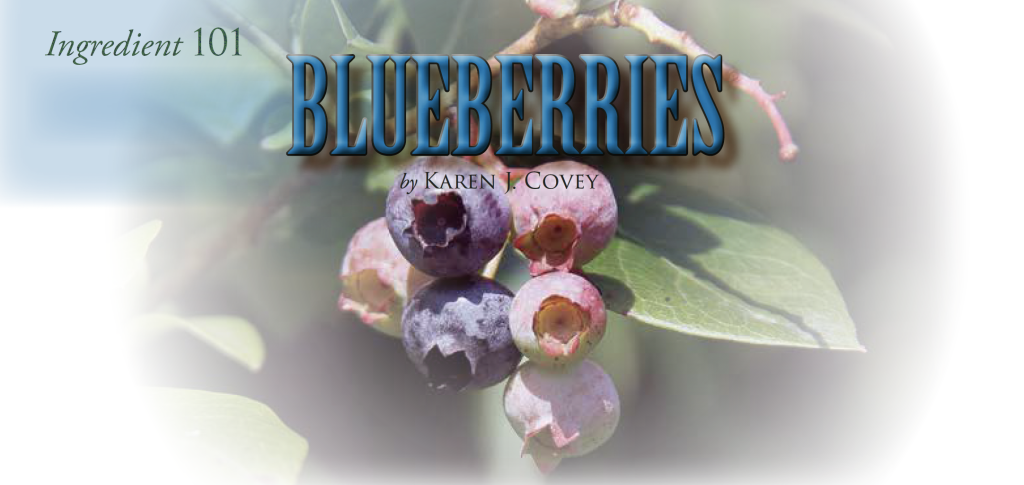
By Karen J. Covey.
In the middle of the summer when blueberries are at the peak of their season, a trip to a pick-your-own farm is always a must for me. In truth, I typically go several times a season. Blueberries are a perfect snack on a hot summer day and they freeze really well, allowing me to enjoy them for months to come.
Blueberries are one of the best natural sources of antioxidants because they contain proanthocyanidins (also known as PACs), a chemical compound that gives fruits and flowers their red, blue, or purple colors. They’re also a good source of fiber, vitamin C, vitamin K, and manganese. Plus, in one cup of blueberries (about a handful) there are only about 80 calories and virtually no fat, making them an ideal snack anytime you need a burst of blue.
The Best Flavor
When picking, look for blueberries that are blue all the way around, as those will be at their sweetest peak—pinkish blueberries are not yet ripe, and they’re tart. After picking, go through all the blueberries and remove any leaves, stems, or immature or blemished berries. Place them in a bowl on the counter until they’re at room temperature (they might still be a little warm from the sun). Once cooled, store as desired.
- In the refrigerator: store unwashed blueberries in a paper towel-lined plastic bag or sealable container, with another layer of paper towels on top of the berries. Make sure the cover is slightly open/ajar, allowing excess moisture to escape, for up to 10 days. Wash blueberries just before using them.
- In the freezer: spread unwashed blueberries onto a baking sheet into a single layer. Place baking sheet in the freezer until blueberries have frozen. Once frozen, transfer frozen blueberries into clean plastic bags or sealable containers and freeze for up to one year. Wash blueberries just before using them.
Get Growing
If you’re looking to grow your own, a visit to your local nursery is the best place to start. There are several types of blueberries available including lowbush and highbush and there are several different cultivars available, so it’s important to explore the options and find what’s best for you.
Blueberry bushes grow well in New England and once properly planted are relatively easy to maintain. Blueberries need full sun, good drainage, and require acidic soil to thrive, ideally with a pH of 4 to 5. If you need to lower the pH of your soil, add granular sulfur before planting. Peat moss, pine needles, or coffee grounds are also good additions that will help acidify your soil. Soil preparation is crucial for the success of your blueberries, so spend the time now as it will be worth it later.
Plant blueberries about 3 to 4 feet apart, allowing space all around for easy picking. If possible, plant two or more varieties in a group in your garden for the best production. Blueberry bushes are typically shallow-rooted and should be planted just below the surface, then topped with mulch which will keep the base moist (it needs moisture but also needs to be able to drain). Birds tend to love blueberries, so, if possible, drape some netting over your newly-planted bushes to protect them.
Pick-Your-Own
Blueberries are typically ready for picking around midsummer, beginning in July and extending into August, depending on the cultivar. Because conditions can change quickly, check with your local farm first before planning your trip, ideally through their social media (as many busy farms either don’t have or don’t frequently update their websites).
Here are a few local farms that offer pick-your-own blueberries:
- The Blueberry Farm, 698 W Washington St., Hanson, MA
- C. N. Smith Farm, 325 South St., East Bridgewater, MA (a beloved eSEMA Partner Farm)
- Dufort Farms, 55 Reservoir Ave., Rehoboth, MA
- Osamequin Farm, corner of Walnut and Prospect St., Seekonk, MA
- Tree-Berry Farm, 135 Cornet Stetson Rd., Scituate, MA
- U Pick Blueberries, 325 Mary’s Pond Rd., Rochester, MA
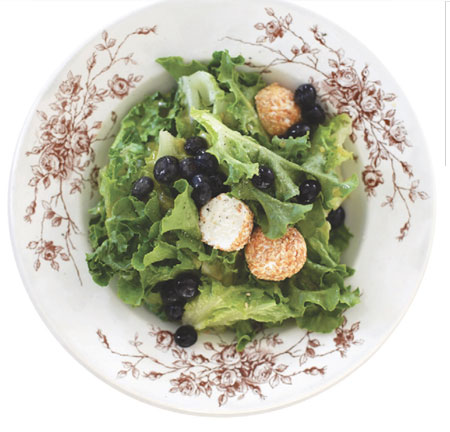
Summer Salad with Pickled Blueberries
Ingredients
- Pickled blueberries
- 1 cup fresh blueberries washed and dried
- ½ cup plus 2 tablespoons water
- ¼ cup white wine vinegar or apple cider vinegar
- ¼ cup sugar
- 1 sprig fresh thyme
- 1 teaspoon black peppercorns
- ½ teaspoon kosher salt
- 1 tablespoon Dijon mustard
- ¼ cup extra virgin olive oil
- Freshly ground black pepper to taste
- ¼ cup sesame seeds
- 8 ounces goat cheese slightly softened
- 1 large bunch mixed greens
- ½ pint fresh blueberries
Instructions
- Pickled Blueberries: place blueberries into a mason jar with about a ½ inch of room at top of jar. Set aside.
- In a nonreactive saucepan, add water, vinegar, sugar, thyme, peppercorns, and salt and bring to a boil. Reduce heat to low and simmer for about 5 minutes. Remove from heat and strain into a mason jar with blueberries. Allow mixture to cool completely. Once cooled, cover and refrigerate until ready to use (at least 1 day but up to 1 week).
- Dressing: in a mason jar, combine 2 tablespoons liquid from cooled pickled blueberries, mustard, and olive oil. Season with salt and pepper. Cover and shake until combined. Taste and adjust as desired.
- Goat Cheese Rounds: Place sesame seeds in a dry saute pan and lightly toast over low heat. Stir seeds as they toast, watching carefully so as to not let them burn (when you just start to smell them, they should be done). Transfer to a small bowl and set aside.
- Using a small ice cream scoop or melon baller, form goat cheese into 1-inch round balls (you should have 10 to 12 balls once finished). Roll each ball in cooled sesame seeds once or twice, coating each ball completely.
- Salad: toss greens with vinaigrette and place in a large serving bowl. Season with salt and pepper. Scatter top with some strained pickled blueberries and goat cheese balls. Serve immediately.
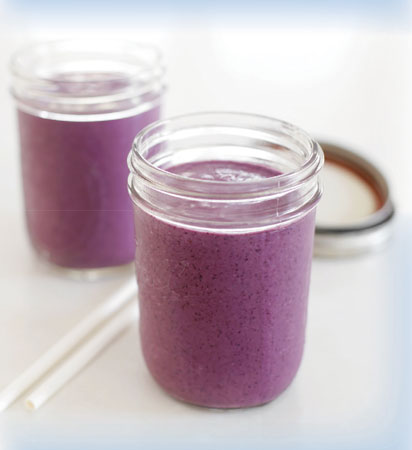
Blueberry Smoothie
Ingredients
- 1½ cups water or more if needed
- ½ cup plain Greek yogurt
- 1 cup frozen blueberries
- 1 frozen banana
- 1 tablespoon honey or to taste
- 1 tablespoon chia seeds optional
- 1 scoop plain protein powder optional
Instructions
- In a high-powered blender, add water, yogurt, blueberries, banana, honey, chia seeds, and protein powder (if using). Process until thick and creamy. Taste and adjust as desired.
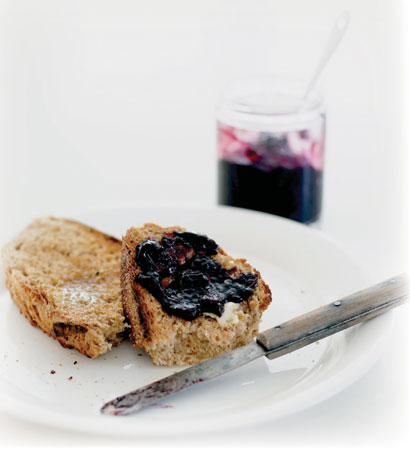
Quick Blueberry Jam
Ingredients
- 2 cups fresh blueberries
- ⅓ cup sugar or to taste (see cook’s note)
- Zest and juice from 1 lemon
- 2 tablespoons chia seeds
- 2 teaspoons vanilla extract
- Pinch kosher salt
Instructions
- In a medium saucepan, add blueberries, sugar, and lemon zest and juice. Cook over medium-high heat, stirring, until some liquid releases. Reduce heat to low and add chia seeds, vanilla, and salt and simmer for 10 to 15 minutes, stirring occasionally, until mixture has thickened and reduced slightly (as you stir, smash blueberries against side of saucepan with back of a spatula as they cook to help beak them down). Taste and adjust as desired. Remove from heat and allow to cool completely.
- Once cooled, either transfer mixture to a food processor and pulse until smooth or refrigerate in an airtight container for up to 2 weeks.

